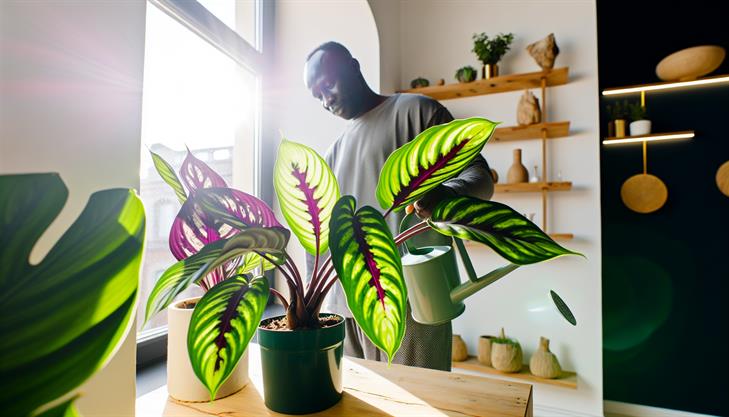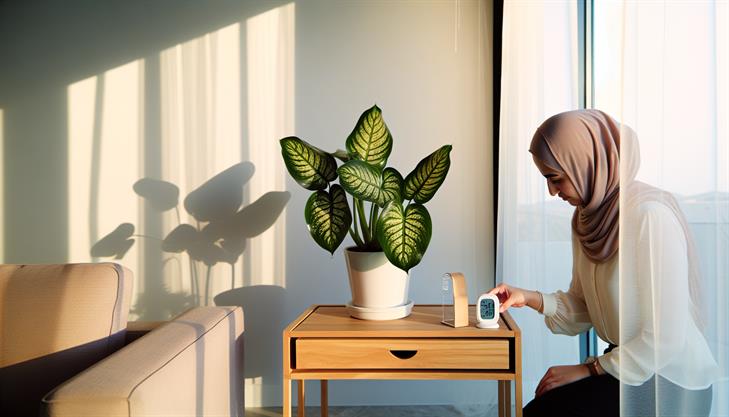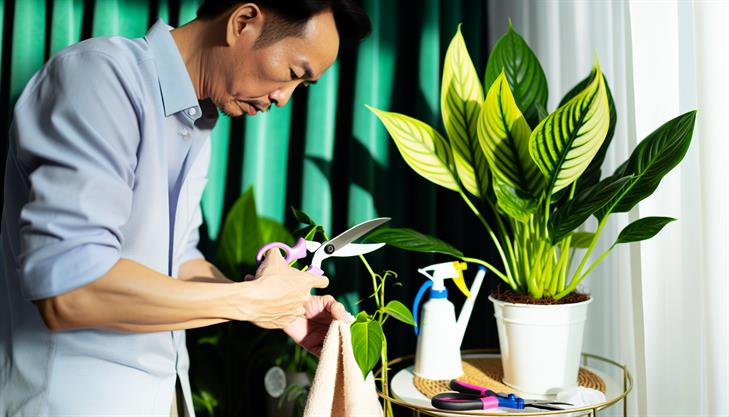In the world of houseplants, few are as visually captivating as the Calathea. Known for their striking foliage, these botanical beauties can transform any space into a lush indoor oasis. But behind their aesthetic appeal lies a unique set of care requirements that can challenge even the greenest of thumbs. Understanding how to properly nurture your Calathea is crucial to maintaining its vibrancy and health. This guide unravels the mysteries of Calathea care, offering you practical tips to ensure your plant flourishes. Whether you’re a seasoned plant parent or a budding enthusiast, diving into these insights will equip you with the knowledge to prevent common pitfalls and cultivate an impressive, lively addition to your home. Get ready to embark on a rewarding journey towards becoming a Calathea care connoisseur, transforming potential plant frustration into flourishing foliage success.
Step-by-Step Guide to Planting Calathea
Caring for a Calathea plant can be a rewarding endeavor, as this tropical species brings vibrant patterns and colors to any indoor space. To ensure your Calathea thrives, follow this step-by-step guide on how to care for Calathea effectively.
1. Choosing the Right Location:
Calatheas prefer bright, indirect light. Direct sunlight can scorch their leaves, while insufficient light may cause them to lose their vibrant patterns. A spot near an east or north-facing window is ideal.
2. Soil Requirements:
Use well-draining potting soil rich in organic matter. A mix containing peat, perlite, and pine bark can enhance drainage while providing necessary nutrients.
3. Watering Techniques:
Keep the soil consistently moist but not soggy. Water once the top inch of soil feels dry to the touch. Use distilled or rainwater if possible, as Calatheas are sensitive to fluoride and chlorine often present in tap water.
4. Humidity Needs:
Calatheas thrive in high humidity environments (around 60% or more). To increase humidity, you can:
- Place a humidifier nearby.
- Group plants together to create a microclimate.
- Use a pebble tray with water under the plant pot.
5. Temperature Preferences:
Maintain a warm atmosphere between 65-80°F (18-27°C). Avoid cold drafts and sudden temperature fluctuations, which can stress the plant.
6. Fertilizing Regimen:
Feed your Calathea every four weeks during the growing season (spring and summer) with a balanced, water-soluble fertilizer at half strength. Reduce feeding in the fall and cease in winter.
7. Pruning and Maintenance:
Regularly remove any brown or yellow leaves to encourage new growth and maintain the plant’s appearance. Trim only the damaged parts of a leaf instead of removing it entirely, maintaining the humidity level to prevent further browning.
8. Repotting Instructions:
Repot the plant every 1-2 years in the spring as needed or when you notice roots growing out of the pot’s drainage holes. Choose a pot that is one size larger with adequate drainage.
Common Issues and Solutions:
- Leaf Cupping or Curling: Ensure your plant is not under-watered and that it has enough humidity. Check for possible pests.
- Brown Leaf Edges: Likely due to low humidity and dry soil. Increase humidity and adjust your watering schedule.
- Fading Leaf Colors: Move to a location with better light or reduce fertilizer if overfeeding.
Additional Tips:
- Avoid placing your Calathea in areas with cold drafts or near heat vents to prevent stress and leaf damage.
- Regularly check for pests, such as spider mites or aphids, which can hinder your plant’s health.
By following these guidelines on how to care for Calathea, you can maintain a healthy and vibrant plant that enhances the beauty of your home environment. With the right conditions and attentive care, your Calathea will reward you with its stunning foliage and vibrant hues.
Essential Tips for Watering and Humidity Control
Calathea plants are popular houseplants known for their vibrant leaves and intricate patterns. Proper care involves paying close attention to both watering and humidity, as these are essential for maintaining their health.
Watering Your Calathea
-
Understand the Plant’s Needs: Calatheas prefer consistently moist soil, but it is crucial to avoid waterlogging, which can lead to root rot. Use a well-draining soil mixture to help manage water retention.
-
Watering Schedule: Generally, water your Calathea when the top inch of the soil feels dry. This usually means watering once a week, but frequency can change based on your home’s environment. During the summer, you might need to water more frequently, while in winter, watering needs might decrease.
-
Use the Right Water: Tap water high in minerals, such as fluoride and chlorine, can cause brown leaf tips. Use distilled, rain, or filtered water to prevent leaf discoloration.
Humidity Control
-
Aim for High Humidity: Calatheas thrive in high humidity environments. A humidity level of 50% or higher is ideal. Low humidity can cause the leaves to curl or develop brown edges.
-
Increase Humidity:
- Use a Humidifier: Placing a humidifier near your Calathea is an effective way to maintain adequate humidity levels.
- Pebble Trays: Set the plant pot on a tray filled with pebbles and water. As the water evaporates, it adds humidity around the plant.
- Grouping Plants: Place your Calathea near other plants to create a microclimate of higher humidity.
- Misting: Lightly mist the leaves with water, but be cautious as excess moisture on the leaves can encourage fungal diseases.
Common Issues and Solutions
-
Leaf Curling: If you notice the leaves curling, it could be a sign of underwatering or low humidity. Check soil moisture and increase humidity levels around the plant.
-
Brown Leaf Edges: This can indicate a lack of humidity or use of tap water with high mineral content. Ensure regular watering with suitable water and raise humidity levels as needed.
-
Pests: Calatheas can attract pests like spider mites. Regularly inspect the undersides of the leaves and remove any pests using insecticidal soap or neem oil.
Additional Care Tips
-
Lighting: Calatheas prefer bright, indirect light. Too much direct sunlight can fade the vibrant leaf colors, whereas too little light can slow growth.
-
Fertilization: Feed your Calathea every month during the growing season (spring and summer) with a balanced, water-soluble fertilizer. Avoid fertilizing in the fall and winter when the plant’s growth naturally slows down.
By closely monitoring watering and humidity levels, while providing the appropriate light and nutrients, you can keep your Calathea healthy and showing off its stunning foliage. Remember, patience and careful observation are key to mastering how to care for Calathea and ensuring it thrives in your home.
Optimizing Light and Temperature for Calathea
Calathea plants are known for their striking, colorful foliage and make for a stunning addition to any home. However, these beautiful plants require specific care to thrive, particularly with respect to their lighting and temperature needs. Ensuring the right balance is crucial for maintaining their vibrant appearance. Here’s a comprehensive guide on how to care for calathea by optimizing light and temperature:
Lighting Requirements:
-
Indirect Light: Calathea thrive in bright, indirect light. Direct sunlight can scorch their leaves, causing the colors to fade or develop unsightly brown spots. Position your calathea in a spot where it can receive filtered sunlight, such as next to a sheer-curtained window.
-
Artificial Lighting: If natural light is insufficient, consider using artificial grow lights. These can supplement the plant’s lighting needs effectively, ensuring they receive about 8-10 hours of light daily.
-
Signs of Incorrect Lighting: Yellowing leaves or a general lack of vibrancy often indicate too much light. Conversely, slow growth or pale leaves suggest insufficient light.
Temperature Preferences:
-
Consistent Temperatures: Calathea prefer a stable environment, ideally between 65°F to 75°F (18°C to 24°C). Avoid areas with drafts, such as near windows or doors, and keep them away from cold air sources during winter.
-
Humidity Levels: As tropical plants, calathea flourish in high humidity. Aim for a room humidity level of 50% or higher. You can increase humidity by using a room humidifier, misting the leaves regularly, or placing the plant on a tray of pebbles and water.
-
Avoiding Temperature Extremes: Protect your calathea from sudden temperature changes. Keep them away from air conditioning vents, heaters, and open windows that can expose them to fluctuating conditions.
Additional Tips:
-
Watering Needs: Use filtered or distilled water to avoid chlorine and fluoride, which can damage the leaves. Water when the top inch of soil is dry, ensuring good drainage to prevent root rot.
-
Common Issues: Brown leaf tips or edges are a frequent problem, often caused by low humidity or mineral-laden water. Adjusting these factors can help restore plant health.
-
Maintenance Tips: Regularly clean leaves with a damp cloth to remove dust, which can interfere with photosynthesis. Occasional pruning helps to remove damaged leaves and encourages new growth.
By following these guidelines, you can provide the perfect environment for your calathea to flourish. Monitoring the plant’s response to changes in light and temperature is key, allowing adjustments to be made as needed. With the right care, your calathea will maintain its striking appearance and become a thriving part of your indoor garden.
Tools and Techniques for Pruning and Maintenance
Calathea plants are popular houseplants known for their vibrant foliage and intricate leaf patterns. Caring for a calathea requires understanding its specific needs to ensure it thrives in your home. Below are detailed steps and tips on how to care for calathea to keep it healthy and lush.
Light Requirements
Calathea plants prefer indirect light and thrive in medium to low light conditions, making them ideal for spaces without direct sunlight. Prolonged exposure to direct sunlight can scorch the leaves, causing browning and curling. Place your calathea near a north or east-facing window where it receives filtered light throughout the day.
Watering Techniques
One of the essential aspects of calathea care is consistent watering. These plants prefer moist soil but can be sensitive to overwatering and poor drainage. Here’s how to water your calathea effectively:
- Check Soil Moisture: Stick your finger into the soil about an inch deep. If it feels dry at this depth, it’s time to water.
- Use Room-Temperature Water: Cold water can shock the roots. Let tap water sit out overnight to reach room temperature and to allow any chlorine to dissipate, as calathea plants are sensitive to chemicals in tap water.
- Water Evenly: Pour evenly around the base until water flows out of the drainage holes, ensuring all the roots get access to moisture.
- Drain Excess Water: Ensure excess water is drained to prevent root rot, a common problem with calathea plants.
Humidity and Temperature
Calathea plants thrive in high humidity, mimicking their natural tropical environment. Here are some tips to maintain adequate humidity:
- Use a Humidifier: A room humidifier can add moisture if your home’s air is particularly dry.
- Pebble Tray: Place the pot on a tray filled with pebbles and water to create a humid microenvironment.
- Regular Misting: Light misting with distilled water can help keep the leaves moist.
Keep your calathea in temperatures between 65°F to 80°F (18°C to 27°C), away from cold drafts or sudden temperature changes.
Soil and Fertilization
Calathea prefers a well-draining potting mix. A mix containing peat, perlite, and orchid bark can provide the right balance of moisture and aeration.
Fertilize your calathea every four weeks during the growing season (spring through summer) with a diluted liquid houseplant fertilizer. In the fall and winter, reduce fertilization as the plant’s growth slows.
Pruning and Maintenance
Regularly inspect your calathea for dead or damaged leaves and prune them to encourage healthy new growth. Use clean, sharp scissors to cut back any unsightly leaves at the base. This not only improves the plant’s appearance but also prevents potential disease spread.
Common Issues and Solutions
- Leaf Curling: Indicates underwatering or low humidity. Increase watering and humidity levels.
- Brown Leaf Tips: Often a sign of low humidity or fluoride sensitivity from tap water. Increase humidity and use distilled water.
- Pests: Spider mites and aphids can occasionally be a problem. Wipe leaves with neem oil or a mild insecticidal soap.
By following these guidelines on how to care for calathea, you can cultivate a thriving plant that adds beauty and vibrancy to any indoor space. Adjust your care routine as needed to respond to seasonal changes or specific plant needs, ensuring your calathea remains a stunning focal point in your home.
Troubleshooting Common Calathea Care Issues
Caring for Calathea plants involves providing the right environment and consistent attention to meet their specific needs. Known for their strikingly patterned leaves, calatheas can bring a touch of tropical appeal to any indoor space. Here’s a comprehensive guide to ensure your Calathea thrives, along with troubleshooting tips for common issues.
Understanding Light Requirements
Calathea plants prefer bright, indirect light. Direct sunlight can scorch their leaves, fading the intricate patterns. To care for your Calathea properly, position it near a north or east-facing window, where it will receive gentle sunlight. If natural light is limited, consider using fluorescent lighting to mimic these conditions.
Managing Water and Humidity
Calatheas are native to tropical regions, meaning they love moisture and humidity. Use these steps to manage your plant’s watering routine:
-
Regular Watering: Use distilled or rainwater, as tap water can contain minerals and chemicals that harm Calathea leaves. Water your plant when the top inch of soil feels dry—typically every 1-2 weeks.
-
High Humidity: Calatheas thrive in humidity levels above 60%. Increase humidity by misting the leaves regularly, placing a humidifier nearby, or setting the pot on a tray filled with pebbles and water (ensure the pot isn’t directly sitting in water).
-
Temperature: Keep temperatures between 65°F and 80°F. Avoid drafts or sudden temperature changes, which can stress the plant.
Soil and Potting Needs
The right soil and pot are crucial for Calathea care:
- Well-Draining Soil: Use a light, airy potting mix that retains some moisture. A mixture of peat, perlite, and pine bark works well.
- Pot with Drainage: Choose a pot with drainage holes to prevent water from pooling at the bottom, which can lead to root rot.
Fertilizing Practices
Feed your Calathea every month during the growing season—from spring through early fall—with a balanced, water-soluble fertilizer. Reduce feeding frequency in the winter when growth slows down. Always follow the manufacturer’s guidelines to avoid over-fertilizing, which can cause leaf browning.
Pruning and Maintenance
Prune your Calathea for optimal health:
- Remove Damaged Leaves: Trim away any brown or yellow leaves to help encourage new growth.
- Clean the Leaves: Gently wipe leaves with a damp cloth to remove dust, allowing for better light absorption.
Troubleshooting Common Issues
Here are solutions for problems you might encounter:
- Curling Leaves: Often a sign of underwatering or low humidity. Increase watering and humidity as needed.
- Brown Leaf Edges: May indicate low humidity or exposure to chemicals in tap water. Use distilled water and boost humidity.
- Pest Infestations: Watch for pests like spider mites. Combat them by regularly misting the plant or using insecticidal soap if necessary.
By following these guidelines and adjusting your approach based on your plant’s specific needs, you can effectively care for your Calathea and enjoy its beauty for years to come. Remember, consistency and attention to detail are key to keeping your Calathea healthy and vibrant.
In conclusion, caring for calathea plants can be a fulfilling endeavor that brings beauty and vibrancy to your indoor space. By understanding and catering to their specific needs, such as maintaining the right humidity levels, providing filtered light, and keeping the soil consistently moist but not waterlogged, you ensure that your calathea thrives. Regularly wiping their leaves and watching for signs of pests or diseases are equally crucial steps in their upkeep. Remember, every plant has its unique personality, so patience and observation can go a long way in addressing its individual quirks.
As you embark on your calathea care journey, consider setting up a schedule to regularly check the plant’s condition and the environment. This proactive approach not only nurtures their health but also deepens your connection to your leafy friend. Finally, one unique tip for keeping your calathea lush and happy: periodically mist the leaves or place a humidifier nearby, especially in drier months, to mimic their natural tropical habitat. With time and attention, your calathea will reward you with its striking patterns and vibrant leaves. Happy planting!


